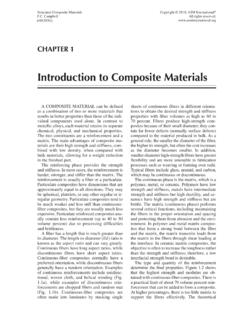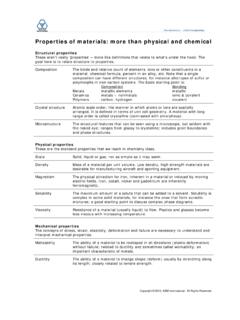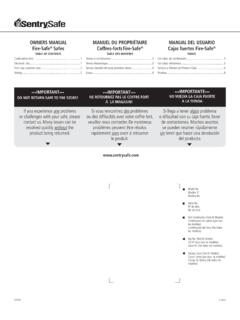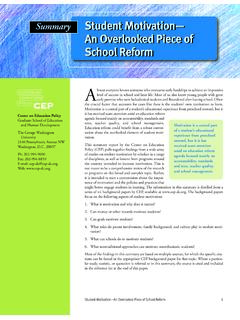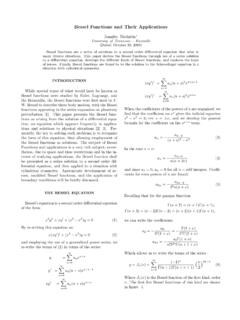Transcription of Basic Understanding of Weld Corrosion - ASM International
1 CHAPTER 1 Basic Understanding of weld CorrosionCORROSION FAILURES OF WELDS occur in spite of the fact that the proper basemetal and filler metal have been selected, indus-try codes and standards have been followed, andwelds have been deposited that possess fullweld penetration and have proper shape andcontour. It is not unusual to find that, althoughthe wrought form of a metal or alloy is resistantto Corrosion in a particular environment, thewelded counterpart is not. Further welds can bemade with the addition of filler metal or can bemade autogenously (without filler metal). How-ever, there are also many instances in which theweld exhibits Corrosion resistance superior tothat of the unwelded base metal. There also aretimes when the weld behaves in an erratic man-ner, displaying both resistance and susceptibil-ity to corrosive Influencing Corrosion of WeldmentsIt is sometimes difficult to determine whywelds corrode.
2 However, one or more of the fol-lowing factors often are implicated: Weldment design Fabrication technique Welding practice Welding sequence Moisture contamination Organic or inorganic chemical species Oxide film and scale weld slag and spatter Incomplete weld penetration or fusion Porosity Cracks (crevices) High residual stresses Improper choice of filler metal Final surface finishMetallurgical cycle of heat-ing and cooling that occurs during the weldingprocess affects the microstructure and surfacecomposition of welds and adjacent base , the Corrosion resistance of auto-genous welds and welds made with matchingfiller metal may be inferior to that of properlyannealed base metal because of: Microsegregation Precipitation of secondary phases Formation of unmixed zones Recrystallization and grain growth in theweld heat-affected zone (HAZ) Volatilization of alloying elements from themolten weld pool Contamination of the solidifying weld poolCorrosion resistance can usually be maintainedin the welded condition by balancing alloy com-positions to inhibit certain precipitation reac-tions, by shielding molten and hot metal surfacesfrom reactive gases in the weld environment, by removing chromium-enriched oxides andchromium-depleted base metal from thermallydiscolored (heat tinted) surfaces, and by choos-ing the proper welding MicrostructuresWeldments exhibit special microstructuralfeatures that need to be recognized and under-stood in order to predict acceptable corrosionservice life of welded structures (Ref 1).
3 This 2006 ASM International . All Rights of Weldments (#05182G) of WeldmentsFig. 1 Schematic showing the regions of a heterogeneousweld. Source: Ref 2 Fig. 2 Concentration profile of chromium and nickel acrossthe weld fusion boundary region of type 304 stainless steel. Source: Ref 4chapter describes some of the general character-istics associated with the Corrosion of weld -ments. The role of macrocompositional andmicrocompositional variations, a feature com-mon to weldments, is emphasized in this chap-ter to bring out differences that need to be real-ized in comparing Corrosion of weldments tothat of wrought materials. More extensive pre-sentations, with data for specific alloys, aregiven in the chapters which immediately inherently possess compositionaland microstructural heterogeneities, which canbe classified by dimensional scale. On the largestscale, a weldment consists of a transition fromwrought base metal through an HAZ and intosolidified weld metal and includes five mi-crostructurally distinct regions normally identi-fied (Ref 2) as the fusion zone, the unmixedregion, the partially melted region, the HAZ, andthe unaffected base metal.
4 This microstructuraltransition is illustrated in Fig. 1. The unmixedregion is part of the fusion zone, and the partiallymelted region is part of the HAZ, as describedbelow. Not all five zones are present in any givenweldment. For example, autogenous (that is, nofiller metal) welds do not have an unmixed fusion zoneis the result of meltingwhich fuses the base metal and filler metal toproduce a zone with a composition that is most often different from that of the base compositional difference produces a galvanic couple, which can influence the corro-sion process in the vicinity of the weld . This dissimilar-metal couple can produce macro-scopic galvanic fusion zone itself offers a microscopicgalvanic effect due to microstructural segrega-tion resulting from solidification (Ref 3). Thefusion zone also has a thin region adjacent to thefusion line, known as the unmixed (chilled)region, where the base metal is melted and thenquickly solidified to produce a compositionsimilar to the base metal (Ref 4).
5 For example,when type 304 stainless steel is welded using afiller metal with high chromium-nickel content,steep concentration gradients of chromium andnickel are found in the fusion zone, whereas theunmixed zone has a composition similar to thebase metal (Fig. 2).Heat-Affected HAZ is the por-tion of the weld joint which has experiencedpeak temperatures high enough to producesolid-state microstructural changes but too lowto cause any melting. Every position in the HAZrelative to the fusion line experiences a uniquethermal experience during welding, in terms ofboth maximum temperature and cooling , each position has its own microstructuralfeatures and Corrosion partially melted region is usually one ortwo grains into the HAZ relative to the fusionline. It is characterized by grain boundary liqua-tion, which may result in liquation cracks, which are found in the grainboundaries one or two grains below the fusionline, have been identified as potential initiationsites for hydrogen-promoted underbead crack-ing in high-strength Base MetalFinally, that partof the workpiece that has not undergone anymetallurgical change is the unaffected basemetal.
6 Although metallurgically unchanged, theunaffected base metal, as well as the entire weldjoint, is likely to be in a state of high residualtransverse and longitudinal shrinkage stress, 2006 ASM International . All Rights of Weldments (#05182G) 1: Basic Understanding of weld Corrosion / 3 Fig. 3 Effect of welding heat on microstructure, hardness,and Corrosion potential of three aluminum alloy welded assemblies. (a) Alloy 5456-H321 base metal with alloy5556 filler. (b) Alloy 2219-T87 base metal with alloy 2319 filler.(c) Alloy 7039-T651 base metal with alloy 5183 filler. Source:Ref 5depending on the degree of restraint imposed onthe a finescale, microstructural gradients exist within theHAZ due to different time-temperature cyclesexperienced by each element of material. Gradi-ents on a similar scale exist within solidifiedmulti-pass weld metal due to bead-to-bead vari-ations in thermal experience.
7 Compositionalgradients on the scale of a few microns, referredto as microsegregation, exist within individualweld beads due to segregation of major andtrace elements during solidification (Ref 3).Forms of weld CorrosionWeldments can experience all the classicalforms of Corrosion , but they are particularly sus-ceptible to those affected by variations inmicrostructure and composition. Specifically,galvanic Corrosion , pitting, stress Corrosion ,intergranular Corrosion , hydrogen cracking, andmicrobiologically influenced Corrosion must beconsidered when designing welded some alloyscan be autogenously welded, filler metals aremore commonly used. The use of filler metalswith compositions different from the base mate-rial may produce an electrochemical potentialdifference that makes some regions of the weld -ment more active. For example, Fig. 3 depictsweld metal deposits that have different corro-sion behavior from the base metal in three alu-minum alloys (Ref 5).
8 For the majority of aluminum alloys, theweld metal and the HAZ become more noblerelative to the base metal, as demonstrated inFig. 3(a) and (b) for a saltwater environment(Ref 5). Certain aluminum alloys, however,form narrow anodic regions in the HAZ and areprone to localized attack. Alloys 7005 and 7039are particularly susceptible to this problem ( ).There are a number of other common welddeposit/base metal combinations that are knownto form galvanic couples. It is common practiceto use austenitic stainless steel welding consum-ables for field repair of heavy machinery, par-ticularly those fabricated from high-strengthlow-alloy steel. This practice leaves a cathodicstainless steel weld deposit in electrical contactwith the steel. In the presence of corrosive envi-ronments, hydrogen is generated at the au-stenitic weld metal cathode, which is capable ofmaintaining a high hydrogen content withoutcracking.
9 However, the cathodic behavior of theaustenitic weld deposit may increase the sus-ceptibility for stress- Corrosion cracking (SCC)in the HAZ of the high-strength steel. A 40%thermal expansion mismatch between theaustenitic stainless steel and ferritic base metalproduces a significant residual stress field in theweldment; this residual stress field also con-(a)(b)(c) 2006 ASM International . All Rights of Weldments (#05182G) of WeldmentsFig. 6 Time-temperature-sensitization curves for type 304stainless steel in a mixture of CuSO4and HSO4con-taining copper. Source: Ref 14. Curves A and B indicate high andmedium cooling rates, 4 Depleted regions adjacent to precipitates. Theseregions cause an electrochemical potential (E) dif-ference that can promote localized Corrosion at the microstruc-tural 5 Intergranular Corrosion ( weld decay) of stainless steelweldmentstributes to cracking susceptibility.
10 A similar, butmore localized, behavior may explain the corre-lation between SCC susceptibility and the pres-ence of retained austenite in high-strength steelweld common dissimilar metal combina -tion involves the use of high-nickel alloys forweld repair of cast iron. Fe-55Ni welding elec-trodes are used to make weld deposits that canhold in solid solution many of the alloying ele-ments common to cast iron. Furthermore, welddeposits made with Fe-55Ni welding consum-ables have an acceptable thermal expansionmatch to the cast iron. Because cast iron isanodic to the high-nickel weld deposit, corro-sive attack occurs in the cast iron adjacent to theweld deposit. It is suggested that cast iron weldsmade with high-nickel deposits be coated(painted) to reduce the susceptibility to selec-tive Corrosion carbon steel weldments can also exhibitgalvanic attack. For example, the E6013 weld -ing electrode is known to be highly anodic toA285 base metal in a seawater environment(Ref 6).






